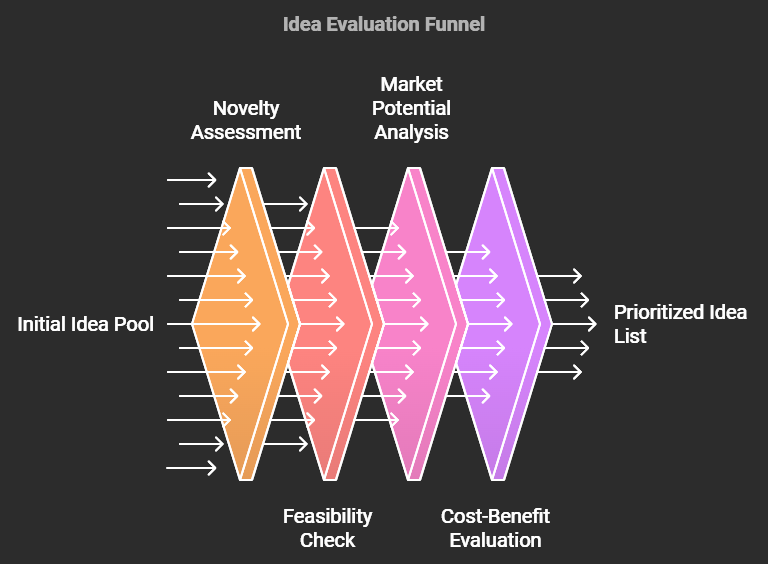Key Criteria for Idea Evaluation Explained
When generating and evaluating new ideas, having a set of criteria is important. This helps to assess their potential. Idea evaluation is a crucial step in the innovation process. It helps determine which concepts have the best chance of success. Understanding the key criteria for idea evaluation allows individuals and teams to make more informed decisions about which ideas to pursue.
In this article, we will explore important factors to consider when evaluating new ideas for their potential impact and feasibility.
Understanding Idea Evaluation
Idea evaluation is a big part of a company’s creative process. It helps refine and prioritize ideas for implementation.
Thoroughly evaluating ideas ensures they align with the company’s brand and objectives, leading to overall success. It also helps identify potential risks and challenges associated with various ideas.
Clear criteria aligned with the company’s goals are essential for effectively evaluating and prioritizing ideas. This includes considering each idea’s novelty, feasibility, and market potential.
Implementing a multi-stage evaluation process involving feedback, metrics, and validation can help identify the most viable ideas for implementation. Scoring and rating methods are also crucial in determining different ideas’ relative value and potential success.
Individuals can evaluate their ideas by considering the benefits relative to the investment required for development. Similar to value investing, this approach includes a cost-benefit analysis to identify the most profitable and successful ideas before pursuing them.
Why Idea Evaluation Matters
Makes Your Ideas Better

Idea evaluation helps improve ideas by identifying original and valuable concepts. It also ensures that the company focuses on ideas with high benefit potential relative to the cost of developing them.
Evaluating ideas assists in refining them for implementation, aligning them with the company’s objectives and brand, and optimizing their value in terms of customer satisfaction and loyalty.
Through idea evaluation, companies can ensure that the concepts align with their brand and objectives. This process helps identify ideas that align with the company’s values and messaging, ultimately keeping the ideas on-brand.
Keeping the idea process clear and organized is important to ensure thorough and effective evaluation. This minimizes the chances of overlooking valuable ideas and provides constructive feedback. Additionally, it allows for using metrics and scoring methods, leading to a systematic and structured approach to idea assessment.
Keeps Ideas On-Brand

Certain criteria must be considered to ensure that ideas stay on brand. Evaluators should look at the newness, feasibility, and market potential of the ideas to see if they fit the brand. Also, comparing an idea’s benefits to its development cost can help maintain brand consistency. Steps like giving feedback, using metrics to evaluate, and adapting different evaluation processes to idea types can ensure that ideas match the brand.
Additionally, scoring and rating methods and validating ideas before implementing them is crucial in keeping ideas on-brand. Following these steps can help refine ideas for implementation and keep the company in line with its branding and goals.
Keeps the Idea Process Clear

Evaluating ideas is important. It helps determine their value and feasibility. Companies gauge ideas using criteria such as novelty, feasibility, market potential, and benefits versus costs. This ensures they align with the company’s objectives and brand.
Managers can use scoring, rating, metrics, and feedback to keep the idea process clear and on-brand. It is crucial to group ideas based on potential, ranking them by benefits and costs, and screening for alignment with company goals.
These strategies create a structured framework for idea evaluation. They ensure that only the most relevant and feasible ideas are pursued, keeping the idea process clear and aligned with company objectives.
Steps to Evaluate Your Ideas
Give Thoughts on Ideas Given
Idea evaluation involves considering various criteria, such as novelty, feasibility, market potential, and potential benefits relative to development costs. By weighing these factors, evaluators can provide thoughtful feedback.
Evaluating and ranking ideas can improve overall idea quality. This ensures that pursued ideas align with company objectives and are feasible in terms of resources and potential market impact. This process helps prioritize promising ideas and allocate resources more effectively.
Considering how well-liked the ideas are and how they align with the company’s brand and objectives is crucial for success. Ideas that resonate with customers and reinforce the company’s brand image can increase customer satisfaction, loyalty, and positive brand associations. Ensuring that ideas align with the brand’s objectives maintains consistency and clarity in the company’s messaging and overall strategy.
Look at How Much People Like the Ideas
When evaluating ideas, companies should measure how much people like them. To do this, they can conduct surveys and focus groups to gather feedback. They can also analyze engagement and response rates on social media and company websites. Considering people’s liking for ideas is important because it affects customer satisfaction, branding, and loyalty, all of which impact a company’s success.
Ideas that resonate with the audience can create value through customer satisfaction and loyalty, contributing to long-term success.
Group Different Ideas Together
Idea evaluation starts with grouping similar ideas. This can be based on characteristics like novelty, feasibility, and potential market impact.
Ideas can be organized into categories such as cost-revenue potential, customer satisfaction, brand value, or technological innovation.
Using these methods, companies can compare ideas, prioritize them, and streamline the evaluation process.
Grouping ideas helps determine their viability for further consideration and development. It allows evaluators to focus on the most relevant aspects and potential benefits.
For instance, ideas that offer significant benefits with minimal investment can be given priority over those requiring substantial investment for similar rewards.
By analyzing the benefits relative to the costs, companies can identify the ideas with the highest potential for profitability and overall positive impact.
Give Ideas Points and Rank Them
To rank ideas accurately, it’s important to consider their novelty, feasibility, and market potential. These factors are key for assessing good business ideas. Companies should also consider benefits beyond financial gain, such as customer satisfaction and branding. Ranking ideas is crucial for deciding which ones to pursue.
For example, a low-cost idea might be more profitable than a fantastic idea with high investment requirements. Companies should assign points to ideas based on their potential value relative to costs. This helps prioritize ideas that align with their objectives and offer significant benefits.
Pick 10 Ideas to Look at More
Evaluating ideas is important. It helps to ensure they match the company’s goals, brand, and what customers want. This process also gets rid of ideas that won’t work and shows which ones could be successful. Choosing 10 ideas to examine more closely lets the company explore many options. It helps to see which ideas are the most valuable and fit the organization’s long-term plans. Ranking ideas helps to focus on the best ones.
This helps the company use its resources well and stay true to its brand and goals. It also makes the innovation process smoother and maximizes successful ideas.
Make Sure Ideas Work Before Starting Them
One way to ensure that ideas work before starting them is to evaluate their promises of benefits relative to the cost of development. By understanding the potential benefits and possible return on investment, companies can prioritize the most feasible and valuable ideas for implementation.
Additionally, idea evaluation can help keep the idea process clear and on-brand by refining ideas for implementation. This ensures that the chosen ideas are aligned with the company’s objectives and maintains consistency with the brand image. Furthermore, screening ideas for success and picking idea checkpoints is critical to ensure that the ideas being pursued have the potential to deliver value to the company. This involves using specific evaluation criteria such as novelty, feasibility, and market potential to identify the most promising ideas and mitigate the risk of investing in less viable concepts.
How to Screen Your Ideas for Success

Pick Your Idea Checkpoints
When evaluating an idea, three key factors—novelty, feasibility, and market potential—should be considered. These factors help determine the idea’s potential value and profitability.
Idea checkpoints are useful for assessing an idea’s potential success by comparing its benefits to its development costs. For instance, an idea with minimal investment but incremental benefit may be more profitable than one with high potential benefit but substantial development costs.
Some idea checkpoints for screening ideas include customer satisfaction, branding, customer loyalty, and financial profitability. By considering these factors, organizations can make informed decisions about which ideas to pursue, ensuring they align with company objectives and provide significant value.
Examples of Idea Checkpoints
Idea checkpoints are important for evaluating and screening ideas within a company. These checkpoints include novelty, feasibility, market potential, and cost-benefit analysis. By assessing each idea’s originality, practicality, market impact, and cost-benefit, these checkpoints help determine its potential success.
Picking the right idea checkpoints ensures that ideas work before starting them. These evaluations refine ideas for implementation and contribute to the company’s overall success. Prioritizing ideas that align with brand objectives and provide value to customers can help companies effectively manage their idea-generation process and select valuable business concepts.
Give Points to Your Checkpoints
To evaluate ideas effectively, consider criteria like novelty, feasibility, and potential market impact. This method helps prioritize ideas objectively and guides further development.
Scoring and ranking ideas is crucial as it approximates the benefits versus the investment in resources and time. This helps highlight ideas with the most potential compared to their costs, making decision-making more informed and strategic.
Comparing benefits relative to development costs can determine each idea’s score. This approach identifies concepts with minimal investment that could yield better results, ensuring an efficient evaluation process.
Give Each Idea Points
Assigning points to each idea can improve the quality and clarity of the idea process. It provides a structured approach to evaluating and comparing ideas, creating a more objective way to identify the most promising ideas. Points can be based on specific criteria for novelty, feasibility, and market potential.
Ranking and grouping different ideas based on these points allows a clear visualization of each idea’s strengths and weaknesses. This helps the company to focus its resources on the most viable and valuable concepts.
Moreover, assigning points to idea checkpoints can be beneficial for screening and selecting successful ideas. It enables a more quantitative and systematic evaluation process. By giving weight to the benefits an idea promises relative to the cost of development, organizations can identify ideas with the highest potential for profitability and long-term success.
This approach fosters a more strategic and value-driven idea evaluation process, ultimately leading to more effective and successful implementation outcomes.
Figure Out Each Idea’s Big Score
To determine which ideas have the most potential, compare their benefits to the cost of developing them. This means looking at the return on investment based on costs versus benefits. This approach can show which ideas would have the most significant impact on the company. Consider factors like feasibility, market potential, and novelty of the idea about the expected investment. Assign numerical scores to these factors and add them up to rank the ideas.
This ranking can help decision-making by providing a reliable way to assess which ideas will most likely drive the company’s success.
For example, you could rank ideas on a scale of one to ten for each criterion, and the idea with the highest sum of all criteria would have the highest potential.
Add Up The Scores and Compare
Adding up the scores and comparing them helps evaluate and select the best ideas. A company can objectively rank ideas by assigning numerical values to criteria like novelty, feasibility, market potential, and overall benefit. This process aligns evaluations with company objectives and brand identity. An effective approach includes clear evaluation criteria, training evaluators on objective scoring, diverse evaluators, and a collective scoring system.

Vizologi is a revolutionary AI-generated business strategy tool that offers its users access to advanced features to create and refine start-up ideas quickly.
It generates limitless business ideas, gains insights on markets and competitors, and automates business plan creation.


